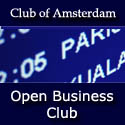"The climate change is reality and increasingly studied and discussed by scientists, media and society. Global warming is not only fact but also apparently human related and gives the alpine tourism industry a tough time. Switzerland Tourism started two years ago to explore how climate changes might influence our tourism. Since then, it has never stopped becoming a popular topic and both solutions and options are being eagerly presented by the rules: "The first one gets the fame". Switzerland Tourisms has now taken two steps back, in order to get a helicopter view over the situation instead reacting too quickly to these complex phenomena." - Martin Nydegger, Director, Switzerland Tourism, The Netherlands
Felix Bopp, editor-in-chief
Join our next Season Event about
And check out our
lab in Girona near Barcelona:
![]() LAB
on
MEDIA and
Human Experience
- May 29&30
LAB
on
MEDIA and
Human Experience
- May 29&30

| .The Future of Travel: The ‘Disappearing Destinations’ of 2020 | |||||||||||||||||||||||||||||||||||

|
By Churchill Travel
Insurance By identifying areas
at risk from tourist damage and climate change now, we can encourage
tourists who are visiting these places to consider the environmental
impact their visit is having, and in doing so hopefully extend the
life of the destination for future generations of holiday makers. |
||||||||||||||||||||||||||||||||||
|
Tomorrow’s tourists may have to take Australia’s Great Barrier Reef and Croatia’s Dalmatian Coastline off their destination wish list. Climate change and tourism damage mean that, like the Seven Wonders of the World, certain sites and attractions could be in danger of disappearing by 2020. The Future of Travel Report*, by travel insurer Churchill, assesses the future prospects of today’s travel destinations. It reveals that World Heritage sites and other tourist destinations popular today, may be permanently closed or restricted by visitor capping or will remain at risk of irreparable damage. Areas of environmental and historical significance such as the Great Barrier Reef, the Everglades or Kathmandu Valley, are likely to have reached visitor capacity by 2020. Such destinations may opt to minimise visitor numbers by continually raising entry costs or by charging additional taxes. It is likely that some destinations will go as far as to introduce visitor capping where travellers will either have to ‘win’ or ‘earn’ the right to holiday in a particular place via a holiday lottery. Some tourist areas, particularly those which involve long haul flights from the UK, may require travellers to store up ‘air mile credits’ based on their personal needs and their overall energy use. Additionally, the social contributions that travellers put back into the communities they visit, may be considered before being granted visitation rights to a particular destination. The report, issued in conjunction with think tank The Centre for Future Studies, reveals the top ten places that are at risk as holiday destinations by 2020: |
|||||||||||||||||||||||||||||||||||
|
|||||||||||||||||||||||||||||||||||
| .News about the future of Tourism | |||||||||||||||||||||||||||||||||||
 |
|
||||||||||||||||||||||||||||||||||
 |
Debate on
Climate Change and Tourism |
||||||||||||||||||||||||||||||||||
| .Club of Amsterdam blog | |||||||||||||||||||||||||||||||||||
 |
April
20: |
||||||||||||||||||||||||||||||||||
| .News about the Future | |||||||||||||||||||||||||||||||||||
 |
|
||||||||||||||||||||||||||||||||||
 |
Hot
Rice with Cold Water An environmental consulting firm and other developers here have come up with a non-perishable food pack that creates steaming hot rice with the simple addition of cold water. The group has recently introduced the product, named "Hotto! Raisu," to the market. By subjecting rice to 4,000 times normal atmospheric pressure, the developers were able to preserve rice for long periods in a soft form that holds moisture. When water is poured over an exothermic agent in the pack, steam warms the rice contained within, and after about 15 minutes, the dish is piping hot. Officials say the product could be useful in areas that have been hit by natural disasters, when electricity is often unavailable. The product is not cheap, costing 10,000 yen [Euro 60] for 30 packs with pickled ume plums, but its producers say they are ready to work on new ideas. |
||||||||||||||||||||||||||||||||||
| .WikiSKY | |||||||||||||||||||||||||||||||||||
|
Users can zoom into the starfield, "dragging" the night sky to reveal various regions and clicking on any object for catalog data. The database is also searchable by name or ID, and many regions of the sky are linked to photographs. Beyond its main display,
WIKISKY includes directly searchable catalogs of the underlying
data, a rather sparse (so far) collection of astronomy-related articles
and a striking gallery of notable objects, including galaxies, globular
clusters, nebulas and quasars. There's enough material here to support
hundreds of hours of browsing, and as it grows the site will make
an increasingly useful resource for amateur astronomers. |
|||||||||||||||||||||||||||||||||||
  
|
|||||||||||||||||||||||||||||||||||
| .Next Season Event | |||||||||||||||||||||||||||||||||||

|
Thursday, May 31 , 2007 Registration: 18:30-19:00, Conference: 19:00-21:15 Where: Info.nl, Sint Antoniesbreestraat 16, 1011 HB Amsterdam [Next to Nieuwmarkt] With Joachim Willms, Managing Director, Tourism Futures Institute The Future Trends in Tourism: Global Perspectives Wybren Meijer, Futureconsult Main Drivers in the Future of Tourism Martin Nydegger, Director, Switzerland Tourism, The Netherlands Switzerland's reaction to the climate change challenge Marc Bolick, Dmarc8 International The Web and Tourism: The Future of Online Travel Moderated by Joep Dirven, Partner & Consultant, X-markt Moderator |
||||||||||||||||||||||||||||||||||
| .Recommended Book | |||||||||||||||||||||||||||||||||||
 |
by David L. Edgell Intelligently designed tourism strategies for the twenty-first century! Successful tourism development and marketing are dependent on maintaining a delicate balance between economic growth and the protection of environments. Managing Sustainable Tourism: A Legacy for the Future tackles the tough issues of tourism such as negative environmental impact and cultural degradation, and provides answers that don’t sacrifice positive economic growth. This essential book offers practical plans for fostering harmonious relationships among local communities, the private sector, not-for-profit organizations, academic institutions, and governments at all levels as well as develops management practices and philosophies that protect natural, built, and cultural environments while reinforcing positive and orderly economic growth. Managing Sustainable Tourism discusses in-depth the sensible guidelines for protecting environment, heritage sites, and local culture while developing realistic tourism goals for compatible economic growth. Useful strategies for sustainable tourism are detailed for each tourism type, along with useful tried-and-true marketing techniques aimed at cooperation and respect for all types of environments. Case studies, research, and supplemental reading lists clearly illustrate ideas and the author’s qualified suggestions. |
||||||||||||||||||||||||||||||||||
| .E-Solex | |||||||||||||||||||||||||||||||||||
|
Eighteen years after
the closure of the production lines in Saint-Quentin, the Solex
has risen from its ashes in a modern form. No longer just economic,
but ecological to boot! |
|||||||||||||||||||||||||||||||||||
   |
|||||||||||||||||||||||||||||||||||
| .Media LAB | |||||||||||||||||||||||||||||||||||
|
|||||||||||||||||||||||||||||||||||





|
|||||||||||||||||||||||||||||||||||
| .Food Art | |||||||||||||||||||||||||||||||||||
|
Source: 
Ayako Suwa makes food art with unexpectedly tasteful results: "This is a special kind of ginger form the Tokyo area. It naturally comes in these colours." From her 'Stimulus and Relaxation' exhibition at POINT gallery in Ebisu last year. 
Hair food 
Utopia food |
|||||||||||||||||||||||||||||||||||
| .Agenda | |||||||||||||||||||||||||||||||||||
|
|||||||||||||||||||||||||||||||||||
|
|||||||||||||||||||||||||||||||||||
|
|||||||||||||||||||||||||||||||||||
| .Club of Amsterdam Open Business Club | |||||||||||||||||||||||||||||||||||

|
Are you interested in networking, sharing visions, ideas about your future, the future of your industry, society, discussing issues, which are relevant for yourself as well as for the 'global' community? The future starts now - join our online platform ...: http://www.openbc.com/go/invuid/Felix_Bopp2 CIWI - Creative Minds Worldwide |
||||||||||||||||||||||||||||||||||
| .Contact | |||||||||||||||||||||||||||||||||||
|
|||||||||||||||||||||||||||||||||||
| .Subscribe & Unsubscribe | |||||||||||||||||||||||||||||||||||
|
|||||||||||||||||||||||||||||||||||
| m | |||||||||||||||||||||||||||||||||||
Copyright © 2002-2007, Club of Amsterdam. All rights reserved.





















